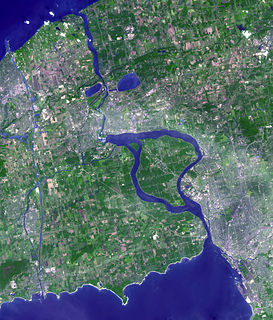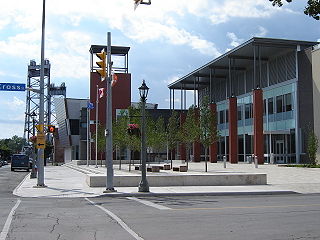
The Niagara River is a river that flows north from Lake Erie to Lake Ontario. It forms part of the border between the province of Ontario in Canada and the state of New York in the United States. There are differing theories as to the origin of the river's name. According to Iroquoian scholar Bruce Trigger, Niagara is derived from the name given to a branch of the locally residing native Neutral Confederacy, who are described as being called the Niagagarega people on several late-17th-century French maps of the area. According to George R. Stewart, it comes from the name of an Iroquois town called Ongniaahra, meaning "point of land cut in two".

Welland is a city in the Regional Municipality of Niagara in Southern Ontario, Canada. In 2016, it had a population of 52,293.

Lewiston is a town in Niagara County, New York United States. The population was 16,262 at the 2010 census. The town and its contained village are named after Morgan Lewis, a governor of New York.

Fort Niagara State Park is located in the Town of Porter in Niagara County, New York, United States. Historic Fort Niagara is located within the park. The 504-acre (2.04 km2) park is northwest of Youngstown near the northern terminus of the Robert Moses State Parkway and is in the Niagara Falls National Heritage Area.

Western New York is the westernmost region of the state of New York. It includes the cities of Buffalo, Rochester, Niagara Falls, Jamestown and the surrounding suburbs, as well as the outlying rural areas of the Great Lakes lowlands, the Genesee Valley, and the Southern Tier. The historic beginnings of the region can be defined by its original eastern boundary of Preemption Line, created by the December 16, 1786 political settlement between the states of New York and Massachusetts, both of which claimed political dominion over the land. This eastern boundary shifted because of changing county borders in the late 18th and early 19th centuries.
The Jamestown Jammers were a minor league baseball team based in Jamestown, New York from 1994 until 2014. The team was the Short-Season A classification affiliate of the Pittsburgh Pirates and played in the New York–Penn League. The team played all of their home games at Russell Diethrick Park.

Sun Lakes-Dry Falls State Park is a public recreation area located at the foot of Dry Falls, three miles west of Coulee City in Grant County, Washington. The state park covers 3,774 acres (1,527 ha) along Route 17 at the head of the Lower Grand Coulee. A privately owned golf course and resort, Sun Lakes Park Resort, is located near the park entrance and Park Lake.

Dunedin Stadium is a baseball field located in Dunedin, Florida. The stadium was built in 1990 and holds 5,509 people. It is the spring training home of the Toronto Blue Jays, as well as home to the Dunedin Blue Jays of the Class A Florida State League and the Dunedin High School Falcons baseball team. The stadium has also been known as Knology Park (2004–2008) and Florida Auto Exchange Stadium (2010–2017).
The Niagara Parkway, formerly known as Niagara Boulevard and historically as the Niagara Road, is a scenic road in the province of Ontario that travels on the Canadian side of the Niagara River from the town of Fort Erie to Niagara-on-the-Lake. The portion north of Table Rock in the city of Niagara Falls is designated as an Ontario Scenic Highway. The Niagara Boulevard was originally the section only from Fort Erie to Chippawa, and the northern portion was referred to as the Niagara Parkway.

New York State Route 61 (NY 61) is a state highway located almost entirely in the city of Niagara Falls in Niagara County, New York, in the United States. The road runs across the city in a northwest–southeast direction, terminating at NY 384 at its southern extent and NY 104 at its northern tip. Conceptually, the road, known as Hyde Park Boulevard, forms the eastern border of downtown Niagara Falls. It is the second-shortest two-digit route in New York after NY 71 in Columbia County. The NY 61 designation was in 1958 after being approved by the Niagara Falls City Council.
The Niagara Falls Rapids were a Class-A minor league baseball team located in Niagara Falls, New York. The team played in the New York–Penn League throughout its existence. The team played all of their home games at Sal Maglie Stadium.
Fontenelle Park is a 108-acre (0.44 km2) public park located at 4575 Ames Avenue, at an intersection of Fontenelle Boulevard in North Omaha, Nebraska. In the late 1940s, the park made headlines across the Midwestern United States as the possible home of a minor league baseball team.
In the U.S. state of Georgia, the Cobb County Parks, Recreation and Cultural Affairs Department is the unit of Cobb county government which handles county parks, recreation facilities, and cultural affairs programs.
The Niagara Falls Citizens were a minor league baseball club, based in Niagara Falls, New York. The franchise can be traced back to 1939 when the Niagara Falls Rainbows were established and played as a charter member of the Pennsylvania–Ontario–New York League. The team was affiliated with the Cleveland Indians in 1939. However, on July 13, 1940, the team relocated to Jamestown, New York to become the Jamestown Falcons.

Arthur Schoellkopf was an American industrial leader who helped develop the hydroelectric resources of Niagara Falls and served as the fifth Mayor of Niagara Falls, New York.
The 2017 Metro Atlantic Athletic Conference Baseball Tournament was held from May 24 through 28. The top six regular season finishers of the league's eleven teams met in the double-elimination tournament to be held at Sal Maglie Stadium in Niagara Falls, New York. Marist won their sixth tournament championship and earned the conference's automatic bid to the 2017 NCAA Division I Baseball Tournament.



















